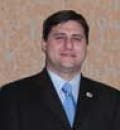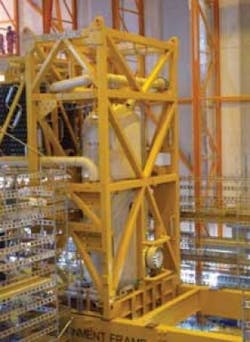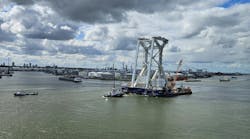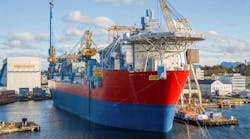Port director’s ‘baptism of fire’ goes with the territory
He soon became one of the spokesmen for the port area on national news media, as well as a point man on various regional and local organizations involved in the logistics of the oil spill cleanup. He also was a member of several groups that almost immediately saw the official deepwater drilling moratorium as a major threat to the economic well being of not only Port Fourchon, but also the entire Louisiana Gulf Coast.
Despite this true baptism of fire, however, Chiasson believes the current down turn in Gulf deepwater exploration drilling is just that, a downturn in a cycle, even though the work stoppage continues to persist more than 11 months after the disaster.
But Port Fourchon is fortunate in that despite the freeze on drilling permits for deepwater and ultra-deepwater wells, a lot of the port’s facilities and its tenants, who are oilfield suppliers and service companies, played active roles in the oil spill containment and reclamation project that followed the blowout, which occurred at BP’s Macondo Prospect in the deepwater Gulf. That non-drilling related work, coupled with the Port Commission electing to ease some rental stipulations, helped ease the pain for port tenants, allowing most of them to avoid major employee lay-offs.
The problem, however, is that the spill cleanup is pretty much over, and the Port Commission, while willing to consider still more concessions to tenants, doesn’t have much more room in which to work.
The commission, a political subdivision of the state of Louisiana made up of nine elected members, was founded in 1960 to promote the economic growth of Port Fourchon, the state’s southernmost port. Commissioners’ terms are for six years and all members are elected at the same time by voters of the 10th ward of Lafourche Parish. It is the only elected port commission in the state.
The commission is tasked with regulating waterborne and airborne trade and commerce within its jurisdiction, which stretches roughly from the Gulf Intracoastal Waterway at the city of Larose to the utmost southern limit of the parish, where Belle Pass reaches the open Gulf of Mexico.
Chiasson, with an undergraduate degree in political science and a master’s degree in public administration, both from Louisiana State University, was director of economic development for the commission before his promotion to the current assignment, which has the formal title of Port Director.
Layoffs lower than expected
In a recent interview withOffshore, Chiasson said most companies engaged in the Gulf deepwater drilling and production market have avoided the kinds of massive lay-offs that occurred during other down cycles, particularly in the early 1980s and mid 1990s. This willingness to keep staff on board is apparent at Port Fourchon as well as many other Louisiana ports serving the offshore petroleum industry.
Schematic of Port Fourchon layout as of Dec. 24, 2010.
“The oil companies and drilling companies have cut hours, have cut pay for individuals some, and have done everything they could to keep their people,” he says. “That also goes for the service and supply companies, the kind who are our tenants. The industry has learned that you have to maintain your key personnel during a downturn, or when things start to come back at some point, they likely will come back strong and the companies will need those people.”
But there’s only so much washing, painting, and sweeping that can be done, and unless the de facto deepwater drilling moratorium changes to allow permits to be handed to producing companies, and soon, there will be increased laying off of personnel in the coming weeks and months, says Chiasson.
And, of course, there’s the trickle-down effect of layoffs in an industry segment important to a specific region. Grocery stores, restaurants, and all consumer service businesses suffer, as well, he pointed out.
“Oil companies and drilling contractors who operate in the deepwater Gulf may be hurting somewhat,” he says, “but they are all multinational companies and they can move out of the Gulf to other parts of the world. But it’s the small, local, fabric of America who remains to suffer the effects of such moves.
That story, he notes, is not being covered as universally by news media as was the blowout, oil spill, and cleanup. The local effects worsen as time passes, while many Americans living far from the Gulf Coast think everything is back to normal.
Honoring the GEST
However, one of the sharpest arrows in the Gulf Coast awareness quiver, says Chiasson, is the progress being made by a team made up of chambers of commerce, businesses, and local elected officials in coastal Louisiana called the Gulf Economic Survival Team (GEST), This relatively small group was formed in June 2010 after the Obama administration’s May order to suspend for a minimum of six months all existing offshore drilling in water depths greater than 500 ft. Though lifted in October, says the group, the moratorium continues in de facto form, particularly for drilling in deep and ultra-deepwater.
But GEST appears to be having success by injecting local and regional economic input in face-to-face meetings with key cabinet members and their deputies in urging them to take swift and appropriate action on federal drilling regulations and to end the permitting slowdown (see related story, page 74).
As a GEST member, Chiasson notes that since early January this year, several delegations have visited Washington, D.C., to talk with Interior Secretary Ken Salazar and his director of the Bureau of Ocean Energy Management, Regulation, and Enforcement (BOEMRE), Michael Bromwich, among others, focusing on community-based information and how the virtual standstill in deepwater drilling permits negatively affects the entire Gulf Coast.
The almost no news coverage in the national media of the GEST visits is an advantage, says Chiasson, since high-level officials like Salazar and Bromwich are much more willing to engage in quiet, but direct, talks about what can be done to get deepwater activity back to former levels.
“Some federal government folks, along with many of the national media, believe that the Macondo incident reflected a lack of attention to human safety and environmental issues by an entire industry,” said Chiasson. “You better believe that the day after that blowout occurred, the entire industry was safer because oil companies, drilling contractors, service companies, and everybody else involved in the offshore industry was double-checking safety and environmental awareness practices and ordering that even more attention in terms of people and money be devoted to those and other important issues from then on.”
Expansion still Port watchword
Despite drilling downturn, the port commission continues its actual and planned expansion projects at both Port Fourchon and the nearby South Lafourche Leonard J. Miller Jr. Airport.
If something good could be said by port officials of the current slowdown, suggests Chiasson, it would be that the commission is getting out in front of things to some degree.
Port Fourchon is, after all, the leading oil and gas terminal on the Gulf Coast, he notes, and for several years prior to the Macondo incident, the port catered to the needs of 90% of the deepwater rigs in the Gulf as well as servicing shallow-water drilling and production activities.
The port has thrived because both operators and the companies who service and supply them with drilling equipment and consumables have changed their mode of operations from locating several or more small facilities all along the coast to be as near to offshore projects as possible, particularly when shallow water drilling and production dominated Gulf activity. However, when they began to move out into deeper water where prospects are far from shore bases, the industry elected to centralize operations at one or two bases, at most. Port Fourchon, the Louisiana port with strategic proximity to such deepwater operations, allowed those companies to consolidate their shore base activities, and the demand to lease Port property climbed quickly.
“During the last five or six years, we’ve been in a ‘catch-up’ mode,” he says. “The demand has been ahead of us with regard to new construction. But we’re now getting a bit ahead, and that’s good.”
When the port commission realized several years ago that Gulf deepwater development would place extraordinary demand on port property, it searched aggressively for expansion options. Moving north of the port’s central E-Slip, a 5,000-ft-wide, 24-ft-deep bulk headed slip on 400 elevated acres, which provides more than 18,600 linear ft of developed waterfront property, was the most feasible and cost-effective option.
The commission then acquired 4,000 acres from landowners and in 2001 began construction on the first phase of its Northern Expansion Project, which more than doubled the size of the port. Construction of Phase 1 is nearly completed. It contains 520 acres of property with 21,000 ft of water frontage and 180 acres of non-waterfront acreage.
According to Chiasson, Phase 1 includes two separate slips, with plans for a third slip. The A-Slip consists of 3,300 ft of fully utilized waterfront acreage. The B-Slip, still under construction, consists of 14,700 ft of waterfront property, of which 10,100 ft is bulk headed. Even though the majority of B-Slip is leased already, the finishing touches are scheduled for completion later this year.
Meanwhile, the third Northern Expansion project project – Phase 2 of the Northern Expansion -- is C-Slip, where dredging and filling are under way. It will be of a very wide slip -- 7,000 ft long by 700 ft wide -- of bulk headed waterfront property on which plans are to offer frontage for large equipment refurbishment, such as for mobile offshore drilling units.
According to Chiasson, in 2003 Louisiana voters passed a constitution amendment to enable individual parishes to forego the ad velorem tax on drilling rigs brought to Louisiana for repair or refurbishment. In 2004, Lafourche Parish voters were the first in the state to repeal this tax, allowing the port to proceed with the design of C-Slip for such work. It is scheduled to be completed in next several years.
The commission also is expanding its facilities to serve the shipping market. Chiasson adds that its location allows easy access for all types of cargoes, including containers or breakbulk. Exports as well as imports can be handled, and trucking can reach any point in the U.S. within three days.
The port’s proximity to Central American also can allow it to handle refrigerated produce that is highly perishable, such as melons, bananas, cucumbers, and squash, to name a few, says Chiasson. What’s more, the port already has a U.S. Customs and Border Protection office, with personnel available to inspect and clear cargo with a minimum of delay. Vessel agency and custom house broker services also are available.
Airport still expanding
The South Lafourche airport in nearby Galliano continues to expand. Brought under the commission umbrella in 2001, it has morphed from a local small plane airport to a center for mid-size corporate jet aircraft as well as for large helicopter services.
The airport now sports a strengthened runway that’s 6,500 ft long and 100 ft wide that can support wheel loads of up to 75,000 lbs. A parallel taxiway was added recently for convenience and to allow multiple aircraft takeoffs and landings on the main runway without interruption.
Additionally, a localizer antenna and distance measuring equipment (DME) have been installed as part of a full instrument landing system. An automated weather observation system (AWOS) has been installed, as have fueling facilities. New hangers for both fixed wing and helicopter aircraft are new additions.
According to Chiasson, the enhanced airfield capabilities allowed the airport to be used extensively for certain mid-sized aircraft taking part in the Macondo cleanup effort, bringing much needed oil spill containment equipment to within easy reach of service vessels used in both offshore and inshore spill cleanup operations.
Offshore Articles Archives
View Oil and Gas Articles on PennEnergy.com







